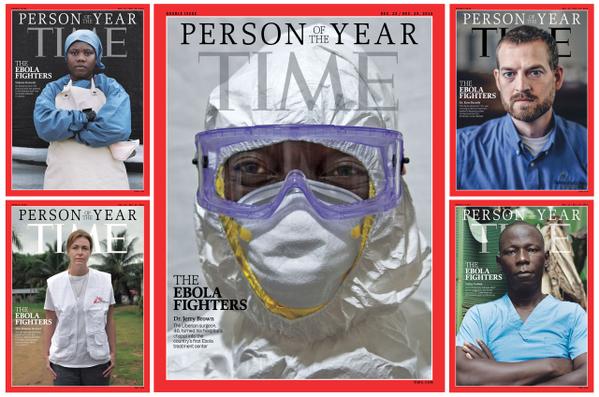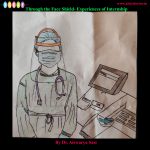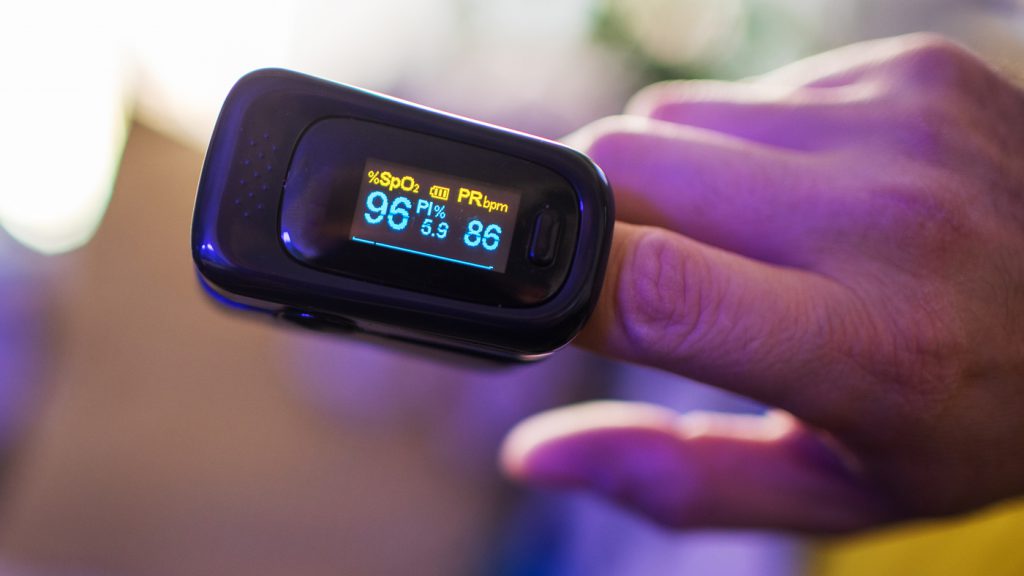
Takuo Aoyagi, a Japanese Bioengineer who pioneered Pulse Oximetry passed away at the age of 84 in Tokyo last month. Pulse oximetry brought about a revolution in the field of medicine, from better monitoring during surgery , to identification of hypoxic patients in the ward. Indeed SpO2 became the fifth vital sign to be recorded on admission for every patient apart form Pulse, BP, Temperature and respiratory rate.
The principle of Pulse oximetry is based on the fact that oxygenated hemoglobin absorbs more infrared light and allows more red light to pass through. Deoxygenated hemoglobin allows more infrared light to pass through and absorbs more red light. The LEDs sequence through their cycle of one on, then the other, then both off about thirty times per second which allows the photodiode to respond to the red and infrared light separately and also adjust for the ambient light baseline.
The history of development of Pulse Oximeter began way back in the early part of 20th century. One of the first ear oximetry devices was introduced in 1939 by Karl Matthes in Leipzig which was based on the counterbalance between red and infrared light. A Pneumatic model was developed by J Squire to squeeze the blood from the web space of the hand which allowed calculation of the baseline absorbance without blood .
There was a lot of stimulus for the development of Oximetry work during World War 2 with the focus to warn pilots of dangerous hypoxia. n 1942, a light weight red and infrared ear oximeter was developed by Glen Millikan for which he coined the word Oximeter. However it had its challenges and did not perform with accuracy. Further work was carried out by Dr. Wood who used the combination of combination of an ear oximeter and pneumatic pressure to counter the challenges and inaccuracies of the device developed by Milikan.
Born on February 14, 1936, in Niigata Prefecture, Japan, Taku Ayogi graduated in 1958 from the Faculty of Engineering at Niigata University with a degree in electrical engineering. In February 1971 he joined the Research Division of Nihon Kohden Corporation. Initially his dream was to make a sensor of blood oxygen saturation to signal the need for artificial ventilation,
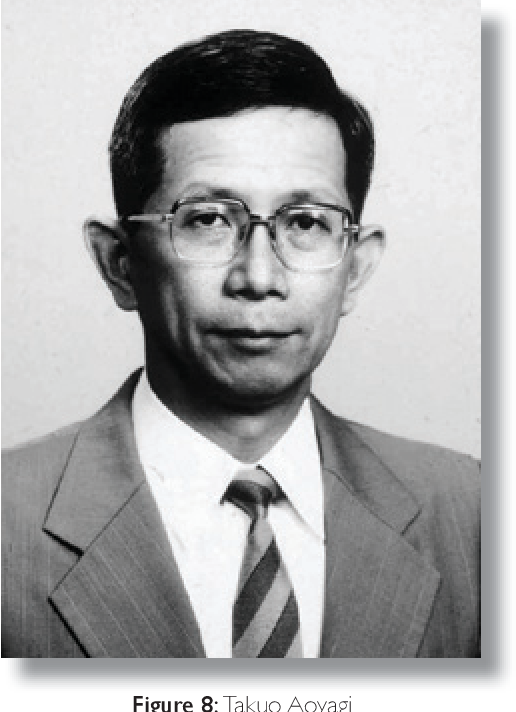
Journal of Clinical Monitoring and Computing 2011
However the major breakthrough in the field of pulse oximetry came perhaps even by serendipity when Takuo Ayogi was trying to use Wood’s ear oximeter as a non invasive method to measure cardiac output by measuring dilution of dye. However he encountered difficulties because of the arterial pulsations creating constant artifacts. However this led him to realise that these changes in pulsation reflect the changes of ONLY arterial blood and the time when pulse is not present could be used as a baseline eliminating the need for having a separate device for pneumatic pressure. Hence he decided that If the optical density of the pulsating portion was measured with two appropriate wavelengths and their ratio was obtained, it would be the same as used by Wood. Secondly by this method only the arterial blood is selectively measured and venous blood does not affect the measurement. This led him to propagate the principle that a probe shift of location, or motion introduces only a brief artifact, before quickly returning to normal measurement.
Various wavelengths and methods of implementing the pulse oximetry idea was tested by Ayogi. He selected the 630-nm wavelength, at which red light absorption was most sensitive to oxygen saturation, and he balanced this against a 900-nm infrared wavelength,. A small tungsten lamp was the light source. The transmitted light was divided into two and each beam was received with combination of an interference filter and a phototransistor.
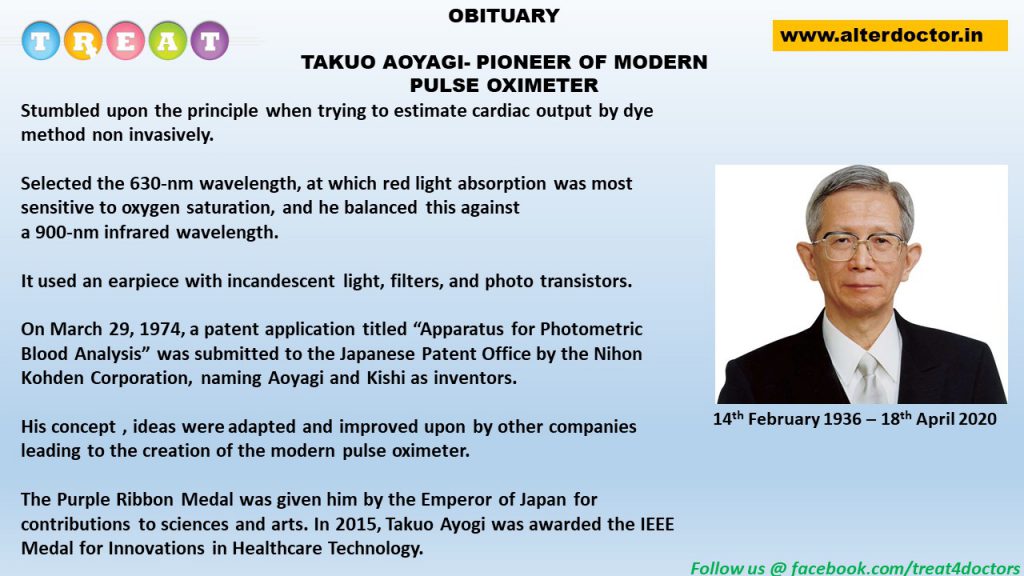
On March 29, 1974, a patent application titled “Apparatus for Photometric Blood Analysis” was submitted to the Japanese Patent Office by the Nihon Kohden Corporation, naming Aoyagi and Kishi as inventors. However unfortunately , his company Nihon Kohden did not continue to develop or market this instrument. Aoyagi was transferred to the patient monitoruing division as an assistant manager. The research and development of the pulse oximeter was assigned to another worker.
There were other groups too working on similar projects. The Minolta Company which already had researchers working on similar concept came out with an oximeter which used a fingertip probe . This principle tried to take advantage of the greater pulse amplitude. Fiberoptic cables were used to conduct light source and signal to and from the instrument. Takuoa Ayogi was appreciative of the work of Minolta for recognising and marketing the idea of Pulse oximeter.
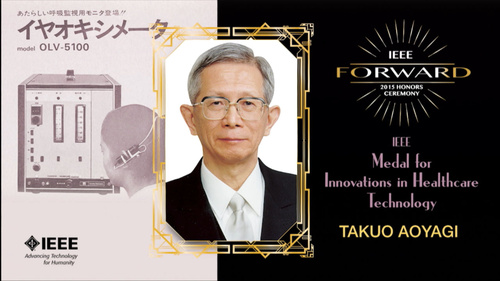
In 2015, Takuo Ayogi was awarded the IEEE Medal for Innovations in Healthcare Technology, the first Japanese to do so. In today’s battle against Corona, where oxygen monitoring plays a key role in early identification of hypoxia, the legacy of Takuo Ayogi will live on.
References: Severing haus, John W. MD Takuo Aoyagi: Discovery of Pulse Oximetry, Anesthesia & Analgesia: December 2007 – Volume 105 – Issue 6 – p S1-S4 doi: 10.1213/01.ane.0000269514.31660.09
Dr.Nitin Yashas is a medical oncology resident and Content Editor at TREAT – ALTERDOCTORS




